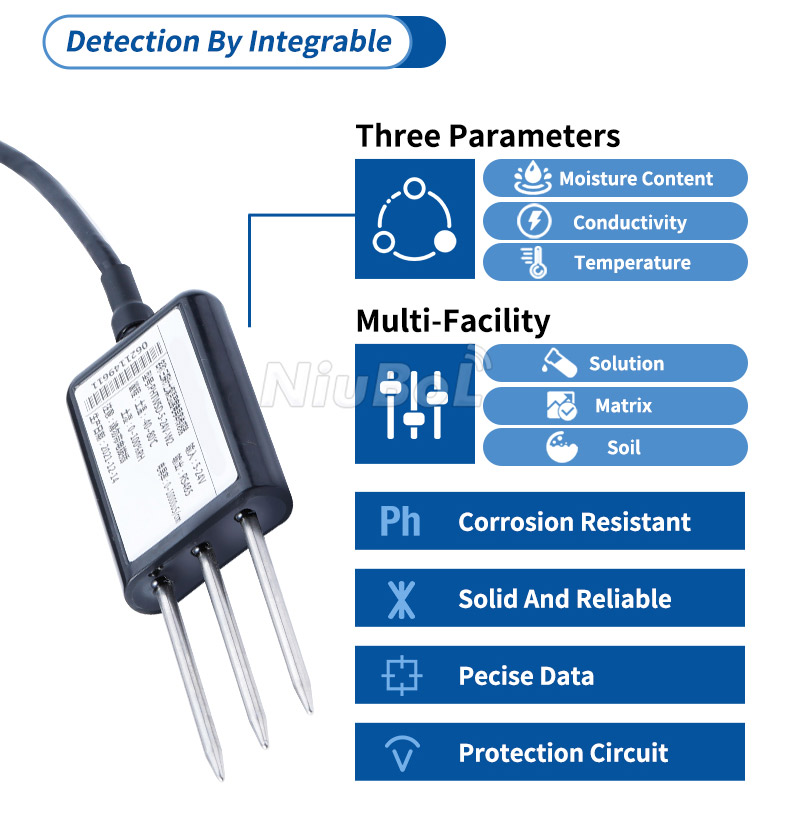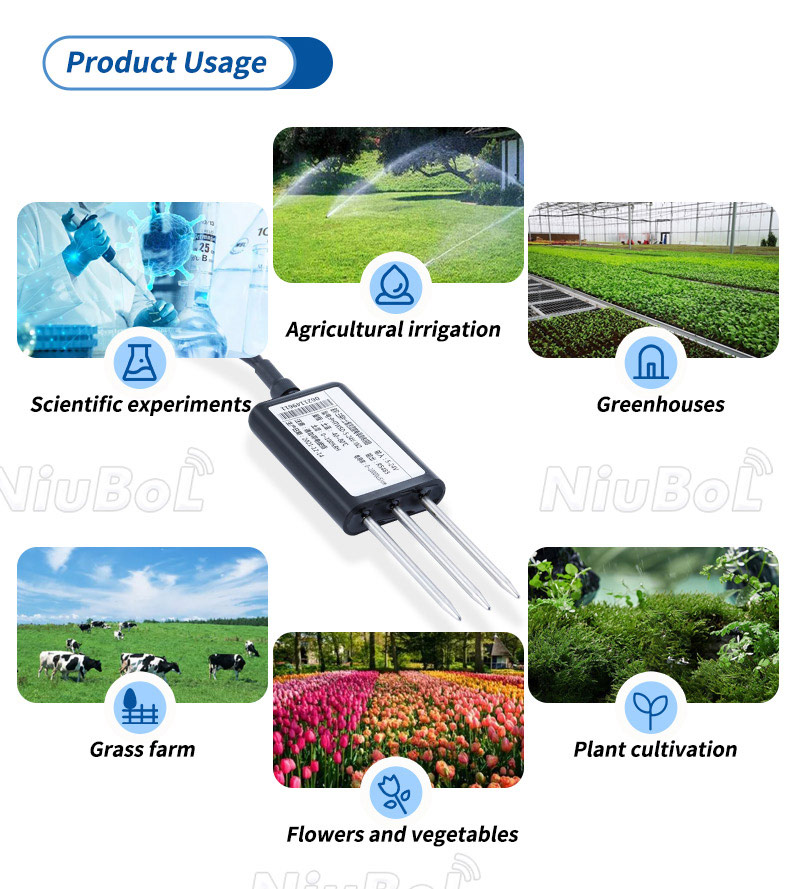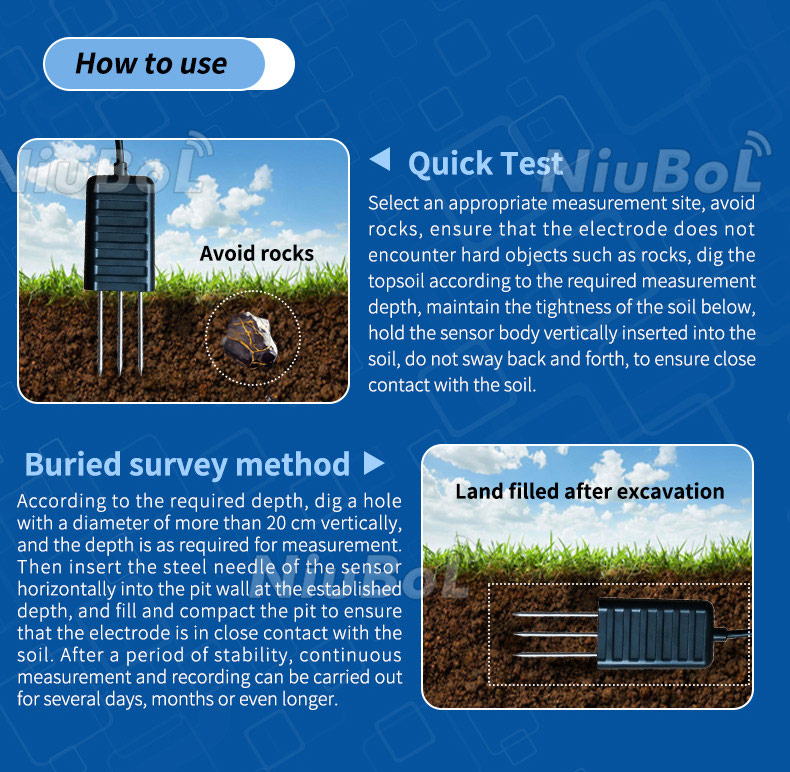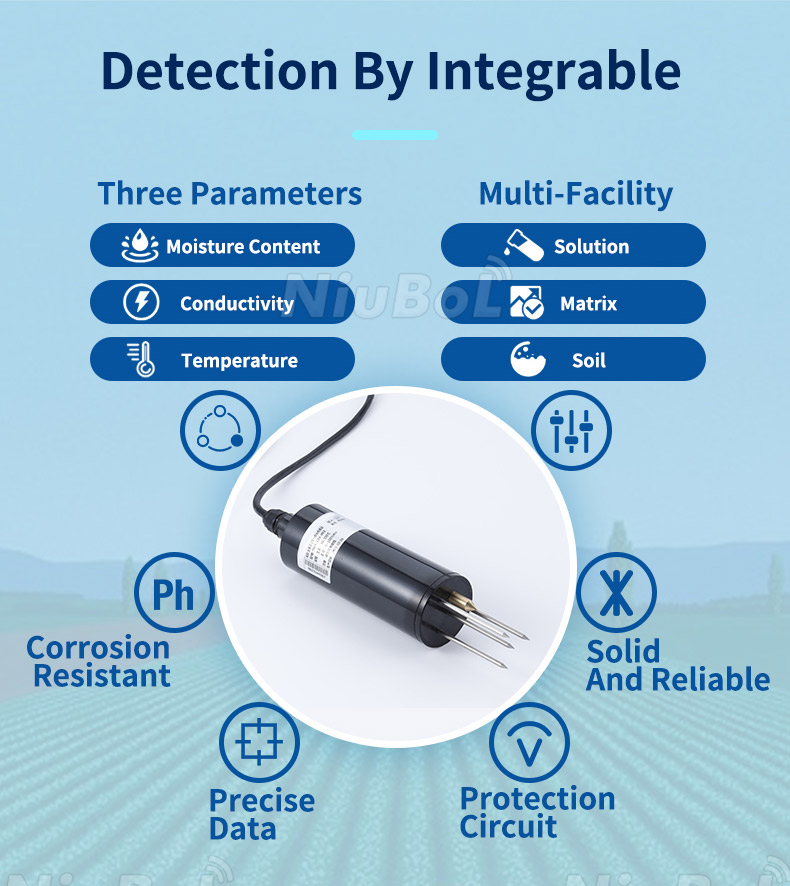

— Blogs —
—Products—
 Consumer hotline +8618073152920
Consumer hotline +8618073152920 WhatsApp:+8615367865107
Address:Room 102, District D, Houhu Industrial Park, Yuelu District, Changsha City, Hunan Province, China
Product knowledge
Time:2024-11-02 15:50:21 Popularity:814
Moisture sensors in agriculture play a vital role in modern agricultural technology. These sensors are not only stable and sensitive, but they can also measure soil temperature and soil moisture at the same time, providing accurate data to support agricultural production.
Soil moisture sensors measure the moisture content of the soil through different physical principles. Common working principles include:
- Principle: The change in soil electrical resistance is utilized to reflect the moisture content. The more moisture in the soil, the lower the resistance.
- Characteristics: Simple structure, low cost, but the accuracy and stability may be affected by soil salinity and temperature.
- Principle: Reflects soil moisture by measuring the change in capacitance between two electrodes. The dielectric constant of the soil varies with moisture content.
- Characteristics: Provides higher accuracy and stability and is suitable for various soil types.
- Principle: Sends a high frequency signal into the soil and analyzes the reflected signal to determine the moisture content in the soil.
- Characteristics: Wide measurement range and immunity to soil salinity for a wide range of soil conditions.
- Principle: Determines moisture content by measuring the propagation speed of electromagnetic waves through the soil.
- Characteristics: Provides very high accuracy, but is costly and complex to install.

- Characteristics: simple construction and low cost, but accuracy and stability may be affected by soil salinity and temperature.
- Characteristics: Provide higher accuracy and stability, and can reflect the dynamic changes of soil moisture more accurately.
- Characteristics: Provides a wide measurement range and immunity to soil salinity for a wide range of soil conditions.
- Characteristics: Provide very high accuracy, but are costly and complex to install.
Soil moisture sensors provide a direct and stable reflection of the true moisture content of various soils by measuring the dielectric constant of the soil. They can measure soil moisture as a percentage by volume, which is the current international standard for soil moisture measurement. Soil moisture sensors play an important role in the following applications:
1. soil moisture monitoring: real-time monitoring of soil moisture status, providing a scientific basis for irrigation.
2. scientific experiments: to provide accurate soil moisture data for agricultural research.
3. Agricultural irrigation: according to the soil moisture data, optimize the irrigation plan, saving water resources.
4. greenhouse: monitor and control soil moisture in greenhouse to improve crop yield and quality.
5. Grassland pasture: Ensure grassland moisture is appropriate to promote the growth of pasture grass.

1. High-strength electrode: suitable for various soil conditions, ensuring long-term stable operation.
2. Digital output: supports Modbus protocol, which is convenient for data transmission and analysis.
3. anti-interference design: maintains stable measurement performance even under strong sunlight.
1. When measuring on hard ground, drill a hole before inserting the sensor and compacting the soil.
2. Prevent the soil moisture sensor from being subjected to severe vibration and shock, and avoid hard objects from striking it.
3. When used in the field or outdoors, pay attention to the shade and protection to prevent the high temperature from affecting the accuracy of measurement.
Soil moisture sensors also play an important role in environmental protection and sustainable development:
1. Reduce chemical pollution: Reduce the excessive use of chemical fertilizers and pesticides through precision irrigation.
2. Protecting biodiversity: Maintaining the balance of soil microbial communities and protecting the ecological environment.
3. responding to climate change: improving the adaptability of agriculture to climate change and reducing the impact of extreme weather.
With the continuous progress of technology, soil moisture sensors will develop in the direction of intelligence, integration and miniaturization, providing more convenient and efficient services for agricultural production and management. Through the application of these advanced technologies, we can better protect soil resources and promote sustainable agricultural development.

Choosing the right soil moisture sensor is a comprehensive process that takes into account a number of factors. Here are some key steps and considerations:
- Irrigation management: a sensor with high accuracy and fast response time is required.
- Scientific experimentation: may require a more accurate and repeatable sensor.
- Environmental monitoring: Long-term stability and weathering may be more important. 2.
- Sandy soils: may require specially designed sensors because sandy soils have poor electrical conductivity.
- Clay soils: may require sensors that can penetrate compact soils.
- Soils with high organic matter content: may affect the measurement accuracy of the sensor and require calibration.
- Measuring range: Make sure the sensor can cover the range of soil moisture you need to monitor.
- Accuracy: Choose a sensor with high accuracy for reliable data.
- Response time: Choose a sensor with the right response speed according to your application needs.
- Stability: Choose a sensor with good long-term stability to reduce maintenance and calibration frequency.

- Weather Resistance: Ensure that the sensor is able to adapt to different climatic conditions such as high temperature, low temperature, humidity, etc.
- Protection level: Select sensors with appropriate protection level against dust and water intrusion.
- Installation method: Select an appropriate installation method based on soil conditions and sensor type.
- Maintenance requirements: Consider the frequency and difficulty of sensor maintenance.
- Data Output: Select the type of data output (e.g. analog output, digital output) that is compatible with your data logging or monitoring system integration.
- Communication protocol: Make sure the sensor supports the communication protocol used by your system.
- Cost-effectiveness: consider the total cost of purchase, installation, maintenance and calibration.
- Brand reputation: choose a reputable brand of soil moisture sensor with a high market rating.
- After-sales service: consider the technical support and after-sales service of the supplier.
- User feedback: check the evaluation and feedback from other users.
- Case study: Refer to case studies in similar application scenarios.
With the above steps, you can shortlist the soil moisture sensor that meets your needs. Remember, the best sensor is not necessarily the most expensive, but the one that best suits your specific needs.
Summarize
Soil moisture sensors in agriculture are a key tool in promoting sustainable agriculture by precisely managing soil moisture, optimizing agricultural resource allocation, and improving crop yield and quality. As technology continues to advance, these sensors will play an increasingly important role in smart agriculture.
1.NBL-S-THR Soil Temperature Moisture Sensor datasheet
NBL-S-THR-Soil-temperature-and-moisture-sensors-Instruction-Manual-V4.0.pdf
2. NBL-S-TMC Soil Temperature Moisture EC Sensor datasheet
NBL-S-TMC-Soil-temperature-and-moisture-conductivity-sensor.pdf
3. NBL-S-TM Soil Temperature Moisture Sensor datasheet
NBL-S-TM-Soil-temperature-and-moisture-sensor-Instruction-Manual-4.0.pdf
4. NBL-S-TMCS Soil Temperature, Moisture, Conductivity and Salinity Integrated Sensor
NBL-S-TMCS-Soil-Temperature-Humidity-Conductivity-and-Salinity-Sensor.pdf
5. NBL-S-TMCS-7 Soil Temperature, Moisture, NPK, Conductivity and pH Integrated Sensor
7-in-1-Soil-Composite-Sensor-Manual.pdf
4. NBL-S-TMCS-8 Soil Temperature, Moisture, NPK, pH, Conductivity and Salinity Integrated Sensor
Related recommendations
Sensors & Weather Stations Catalog
Agriculture Sensors and Weather Stations Catalog-NiuBoL.pdf
Weather Stations Catalog-NiuBoL.pdf
Related products
 Combined air temperature and relative humidity sensor
Combined air temperature and relative humidity sensor Soil Moisture Temperature sensor for irrigation
Soil Moisture Temperature sensor for irrigation Soil pH sensor RS485 soil Testing instrument soil ph meter for agriculture
Soil pH sensor RS485 soil Testing instrument soil ph meter for agriculture Wind Speed sensor Output Modbus/RS485/Analog/0-5V/4-20mA
Wind Speed sensor Output Modbus/RS485/Analog/0-5V/4-20mA Tipping bucket rain gauge for weather monitoring auto rainfall sensor RS485/Outdoor/stainless steel
Tipping bucket rain gauge for weather monitoring auto rainfall sensor RS485/Outdoor/stainless steel Pyranometer Solar Radiation Sensor 4-20mA/RS485
Pyranometer Solar Radiation Sensor 4-20mA/RS485
Screenshot, WhatsApp to identify the QR code
WhatsApp number:+8615367865107
(Click on WhatsApp to copy and add friends)